Fast-food company Yum! Brands (NYSE:YUM) fell short of analysts' expectations in Q1 CY2024, with revenue down 2.9% year on year to $1.60 billion. It made a non-GAAP profit of $1.15 per share, improving from its profit of $1.06 per share in the same quarter last year.
Yum! Brands (YUM) Q1 CY2024 Highlights:
- Revenue: $1.60 billion vs analyst estimates of $1.71 billion (6.6% miss)
- EPS (non-GAAP): $1.15 vs analyst expectations of $1.20 (4.6% miss)
- Gross Margin (GAAP): 50.1%, up from 49.3% in the same quarter last year
- Free Cash Flow of $314 million, similar to the previous quarter
- Same-Store Sales were down 3% year on year (miss vs. expectations of slightly positive)
- Store Locations: 58,748 at quarter end, increasing by 3,065 over the last 12 months
- Market Capitalization: $39.74 billion
Spun off as an independent company from PepsiCo, Yum! Brands (NYSE:YUM) is a multinational corporation that owns KFC, Pizza Hut, Taco Bell, and The Habit Burger Grill.
Specifically, the company’s 1997 strategic separation from PepsiCo was meant to increase focus on the fast-food opportunity.
Each banner within Yum! Brands brings its own unique history and culinary offerings. KFC, famous for its “finger-lickin' good” fried chicken, traces its roots back to Colonel Harland Sanders and his secret blend of herbs and spices. Pizza Hut revolutionized the pizza industry with its dine-in experience and unique creations like the “Original Stuffed Crust” pizza. Taco Bell introduced Mexican-inspired flavors to a wider audience, offering innovative and affordable menu choices. And most recently, The Habit Burger Grill caters to the fast-casual market through its never-frozen, always-fresh burgers.
Yum! Brands has successfully grown its presence internationally by adapting menus and experiences to local tastes and preferences. One example is Pizza Hut’s “Mizza” in Taiwan, which is a pizza using rice instead of traditional dough. Another contributing factor is its focus on customer convenience, evident in the creation of mobile apps that enable online ordering, customization, and rewards programs. Additionally, the company has forged partnerships with popular delivery platforms, ensuring that customers can savor their favorite meals in the comfort of their own homes.
Traditional Fast Food
Traditional fast-food restaurants are renowned for their speed and convenience, boasting menus filled with familiar and budget-friendly items. Their reputations for on-the-go consumption make them favored destinations for individuals and families needing a quick meal. This class of restaurants, however, is fighting the perception that their meals are unhealthy and made with inferior ingredients, a battle that's especially relevant today given the consumers increasing focus on health and wellness.
Yum! Brands’ competitors include include Burger King and Popeyes (owned by Restaurant Brands, NYSE:QSR), Domino’s (NYSE:DPZ), McDonald’s (NYSE:MCD), and Wendy’s (NASDAQ:WEN).Sales Growth
Yum! Brands is one of the most widely recognized restaurant chains in the world and benefits from brand equity, giving it customer loyalty and more influence over purchasing decisions.
As you can see below, the company's annualized revenue growth rate of 4.8% over the last five years was weak , but to its credit, it opened new restaurants and grew sales at existing, established dining locations.
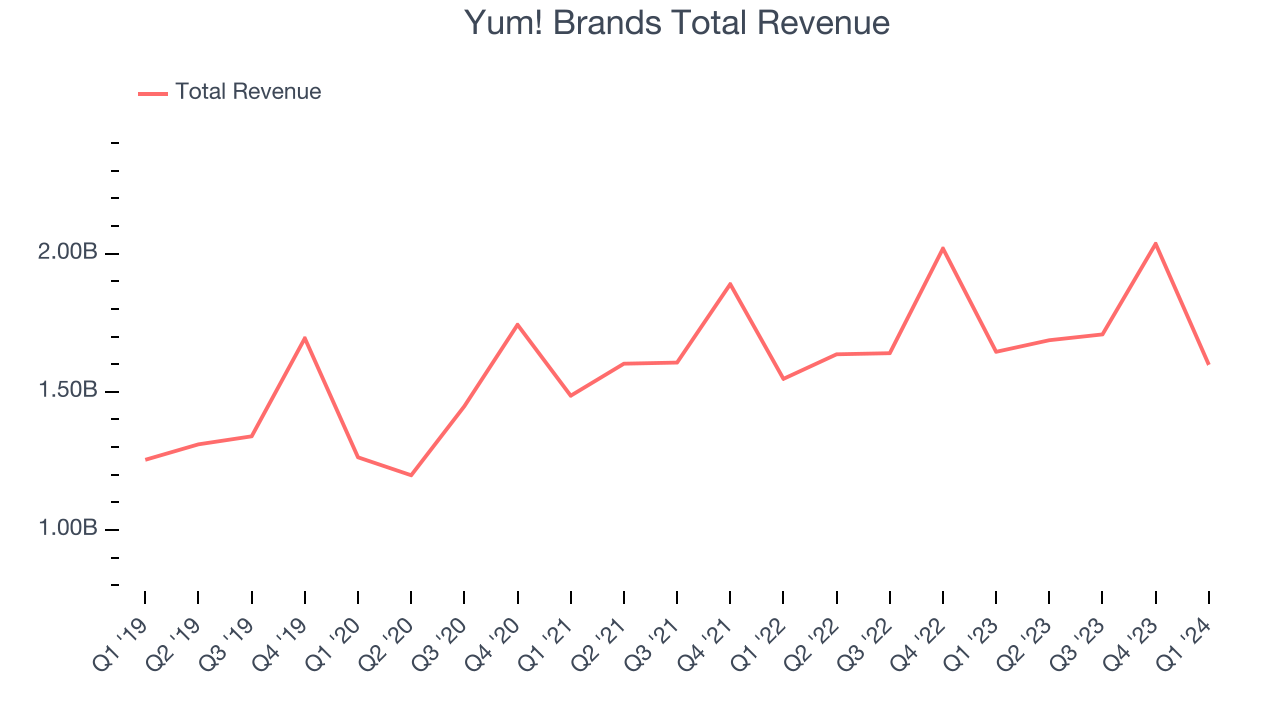
This quarter, Yum! Brands missed Wall Street's estimates and reported a rather uninspiring 2.9% year-on-year revenue decline, generating $1.60 billion in revenue. Looking ahead, Wall Street expects sales to grow 13.2% over the next 12 months, an acceleration from this quarter.
Same-Store Sales
Yum! Brands's demand within its existing restaurants has generally risen over the last two years but lagged behind the broader sector. On average, the company's same-store sales have grown by 4.1% year on year. With positive same-store sales growth amid an increasing number of restaurants, Yum! Brands is reaching more diners and growing sales.
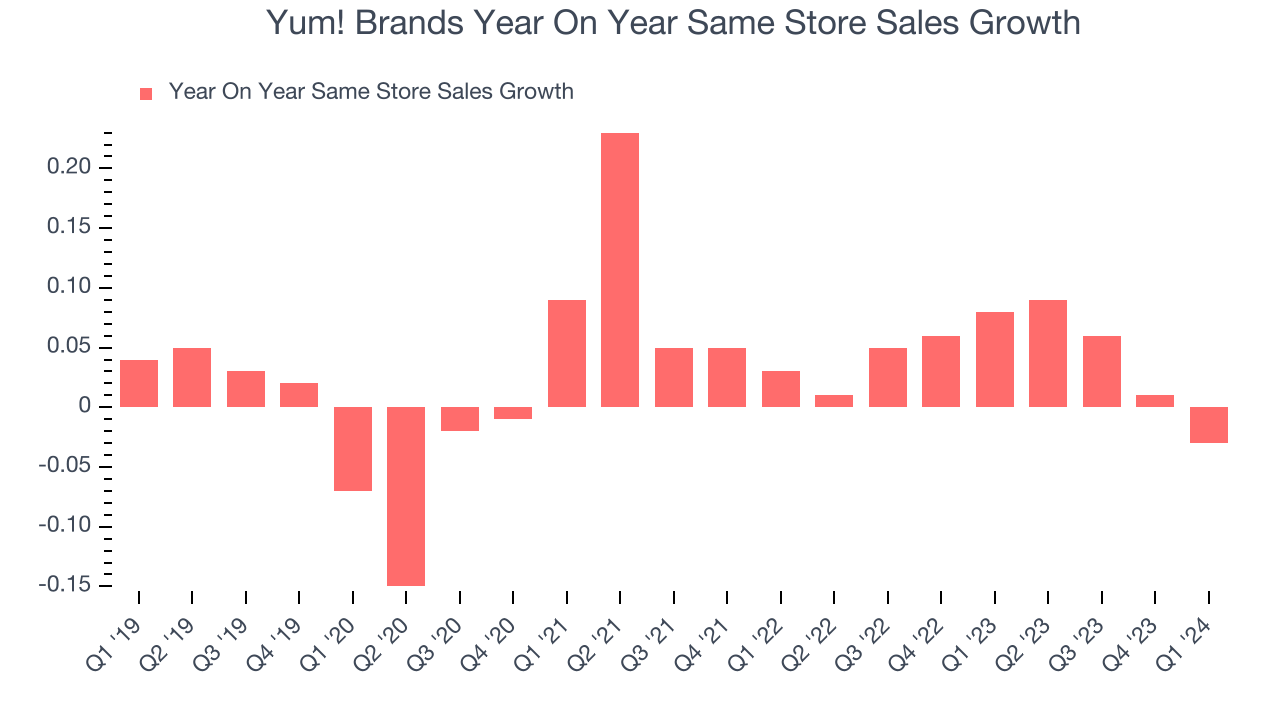
In the latest quarter, Yum! Brands's same-store sales fell 3% year on year. This decline was a reversal from the 8% year-on-year increase it posted 12 months ago. We'll be keeping a close eye on the company to see if this turns into a longer-term trend.
Number of Stores
When a chain like Yum! Brands is opening new restaurants, it usually means it's investing for growth because there's healthy demand for its meals and there are markets where the concept has few or no locations. Since last year, Yum! Brands's restaurant count increased by 3,065, or 5.5%, to 58,748 locations in the most recently reported quarter.
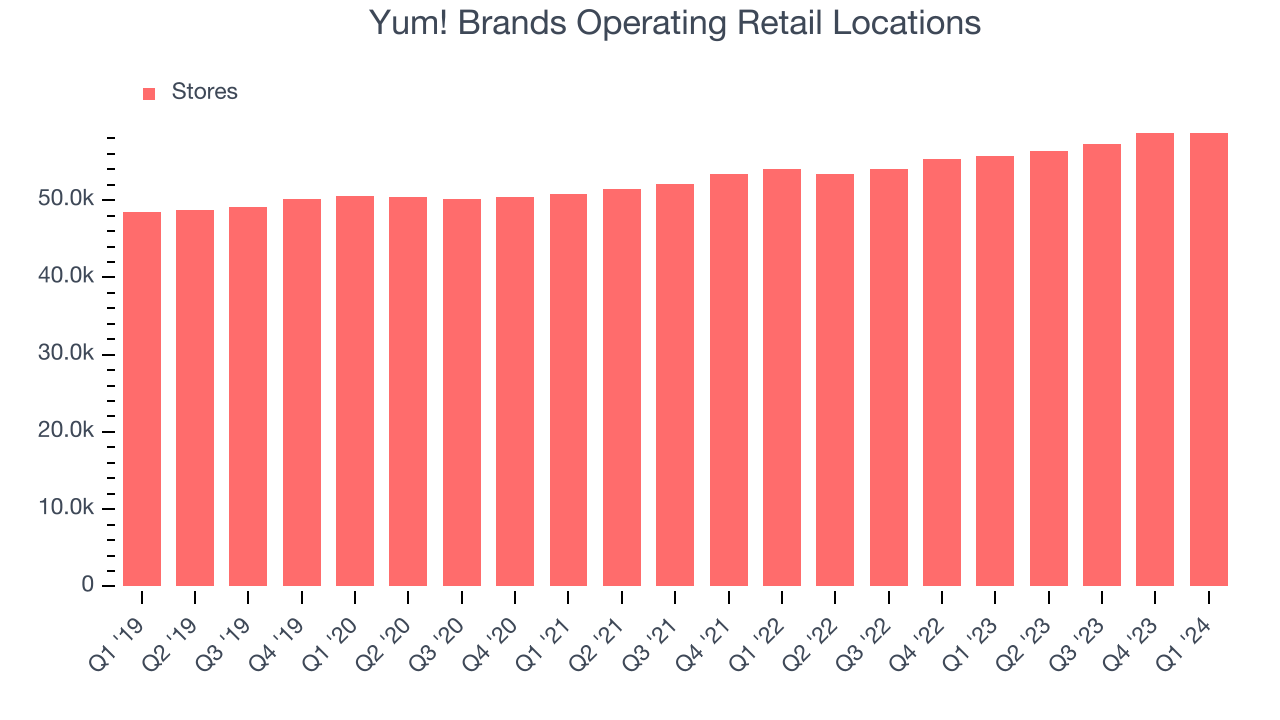
Over the last two years, Yum! Brands has rapidly opened new restaurants, averaging 4.7% annual increases in new locations. This growth is among the fastest in the restaurant sector. Analyzing a restaurant's location growth is important because expansion means Yum! Brands has more opportunities to feed customers and generate sales.
Gross Margin & Pricing Power
We prefer higher gross margins because they not only make it easier to generate more operating profits but also indicate pricing power and differentiation, whether it be the dining experience or quality and taste of food.
In Q1, Yum! Brands's gross profit margin was 50.1%. in line with the same quarter last year. This means the company makes $0.49 for every $1 in revenue before accounting for its operating expenses.
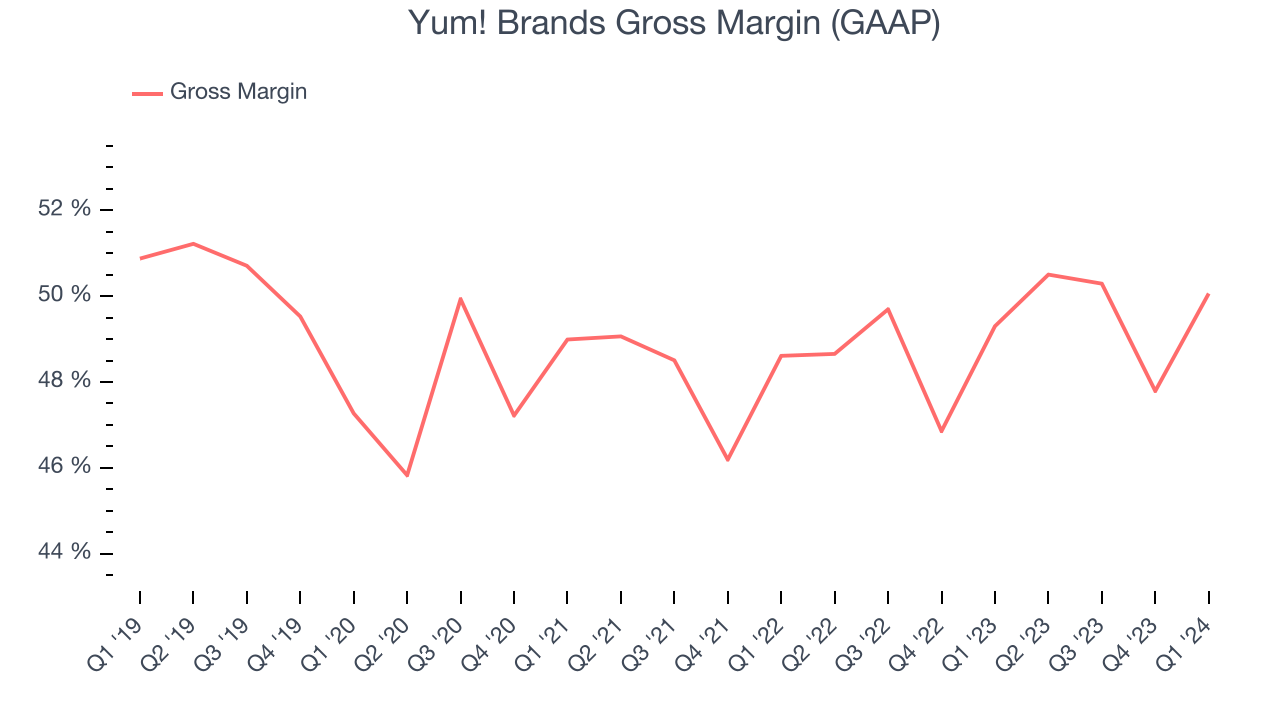
Yum! Brands has best-in-class unit economics for a restaurant company, enabling it to invest in areas such as marketing and talent to stay one step ahead of the competition. As you can see above, it's averaged an exceptional 49.1% gross margin over the last two years. Its margin has also been trending up over the last 12 months, averaging 2.1% year-on-year increases each quarter. If this trend continues, it could suggest a less competitive environment where the company has better pricing power and more stable input costs (such as ingredients and transportation expenses).
Operating Margin
Operating margin is an important measure of profitability for restaurants as it accounts for all expenses keeping the lights on, including wages, rent, advertising, and other administrative costs.
In Q1, Yum! Brands generated an operating profit margin of 32.5%, in line with the same quarter last year. This indicates the company's costs have been relatively stable.
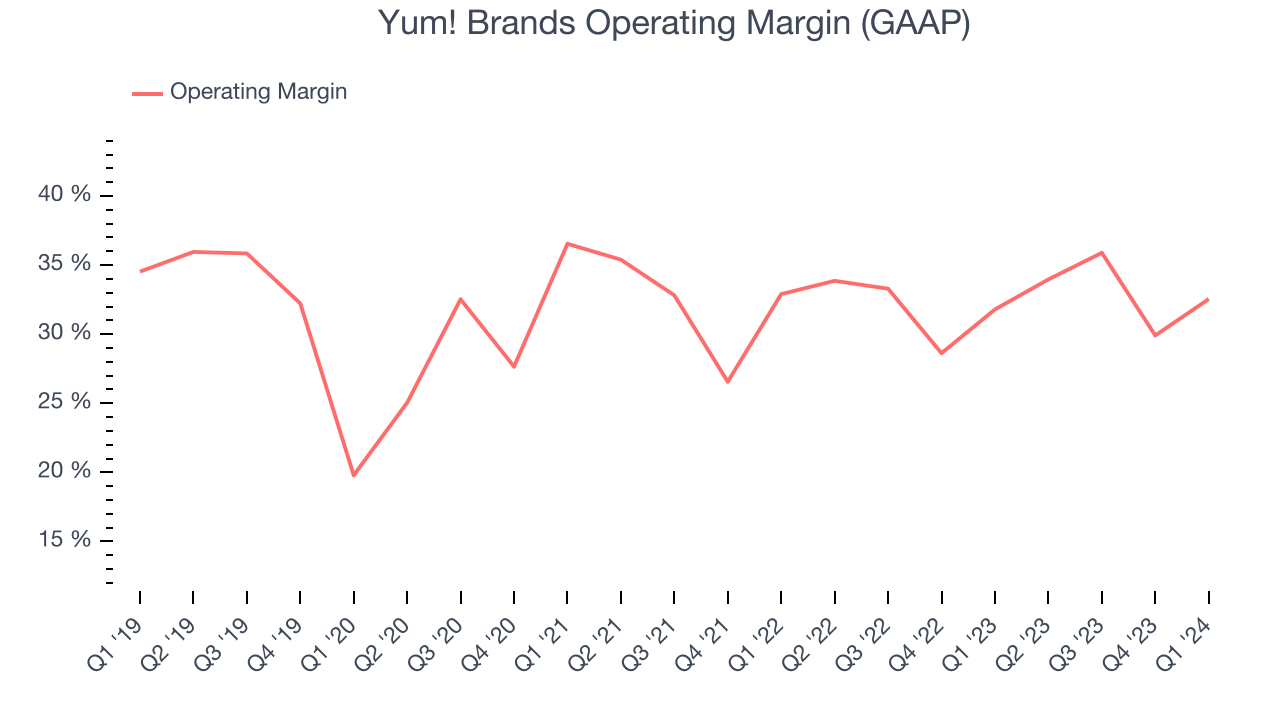 Zooming out, Yum! Brands has been a well-managed company over the last two years. It's demonstrated elite profitability for a restaurant business, boasting an average operating margin of 32.3%. On top of that, its margin has improved, on average, by 1.2 percentage points each year, showing the company is strengthening its fundamentals.
Zooming out, Yum! Brands has been a well-managed company over the last two years. It's demonstrated elite profitability for a restaurant business, boasting an average operating margin of 32.3%. On top of that, its margin has improved, on average, by 1.2 percentage points each year, showing the company is strengthening its fundamentals. EPS
These days, some companies issue new shares like there's no tomorrow. That's why we like to track earnings per share (EPS) because it accounts for shareholder dilution and share buybacks.
In Q1, Yum! Brands reported EPS at $1.15, up from $1.06 in the same quarter a year ago. This print unfortunately missed Wall Street's estimates, but we care more about long-term EPS growth rather than short-term movements.
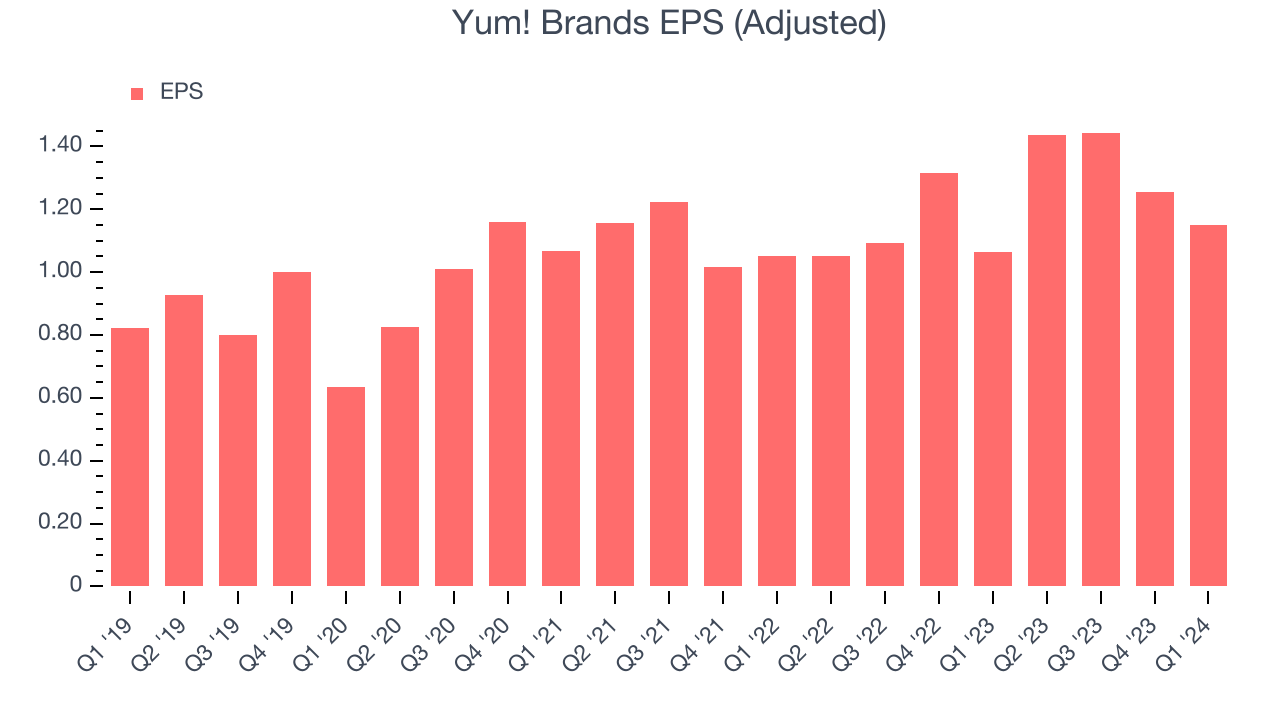
Wall Street expects the company to continue growing earnings over the next 12 months, with analysts projecting an average 12.7% year-on-year increase in EPS.
Cash Is King
If you've followed StockStory for a while, you know that we emphasize free cash flow. Why, you ask? We believe that in the end, cash is king, and you can't use accounting profits to pay the bills.
Yum! Brands's free cash flow came in at $314 million in Q1, up 9.4% year on year. This result represents a 19.6% margin.
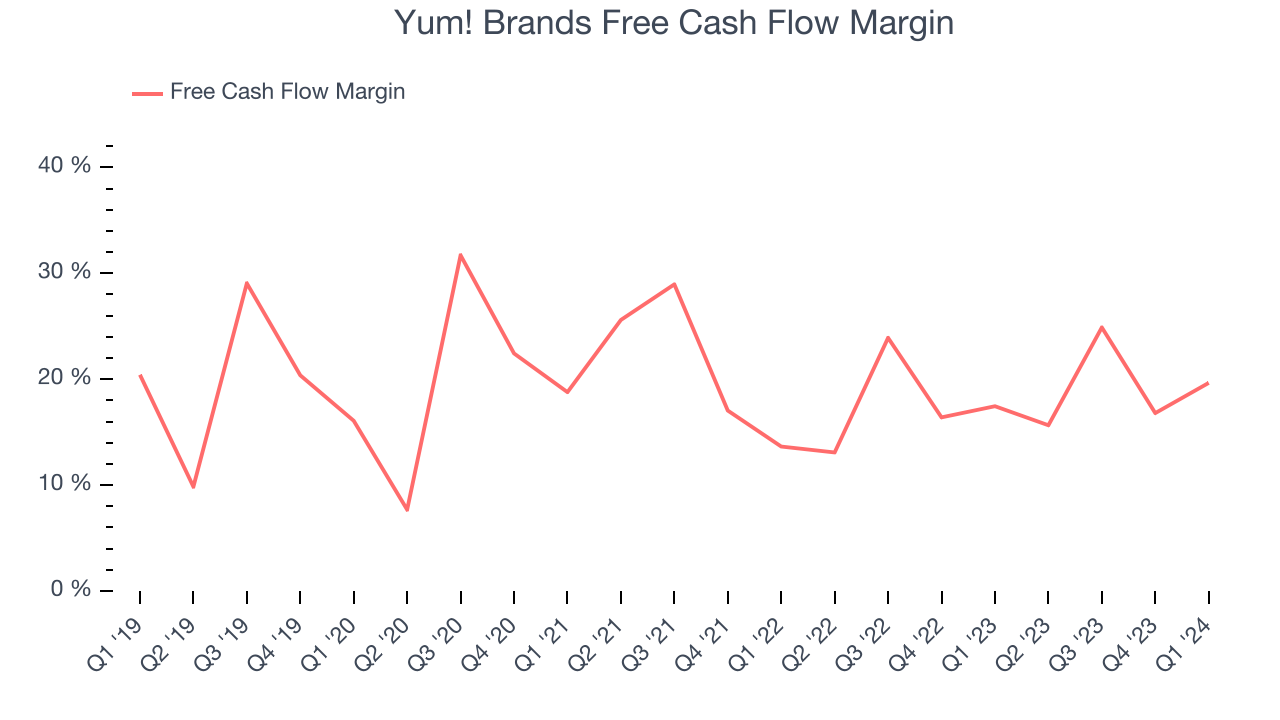
Over the last eight quarters, Yum! Brands has shown terrific cash profitability, enabling it to reinvest, return capital to investors, and stay ahead of the competition while maintaining a robust cash balance. The company's free cash flow margin has been among the best in the restaurant sector, averaging 18.4%. Furthermore, its margin has averaged year-on-year increases of 1.5 percentage points. This likely pleases the company's investors.
Return on Invested Capital (ROIC)
EPS and free cash flow tell us whether a company was profitable while growing revenue. But was it capital-efficient? A company’s ROIC explains this by showing how much operating profit a company makes compared to how much money the business raised (debt and equity).
Yum! Brands's five-year average ROIC was 79%, placing it among the best restaurant companies. Just as you’d like your investment dollars to generate returns, Yum! Brands's invested capital has produced excellent profits.
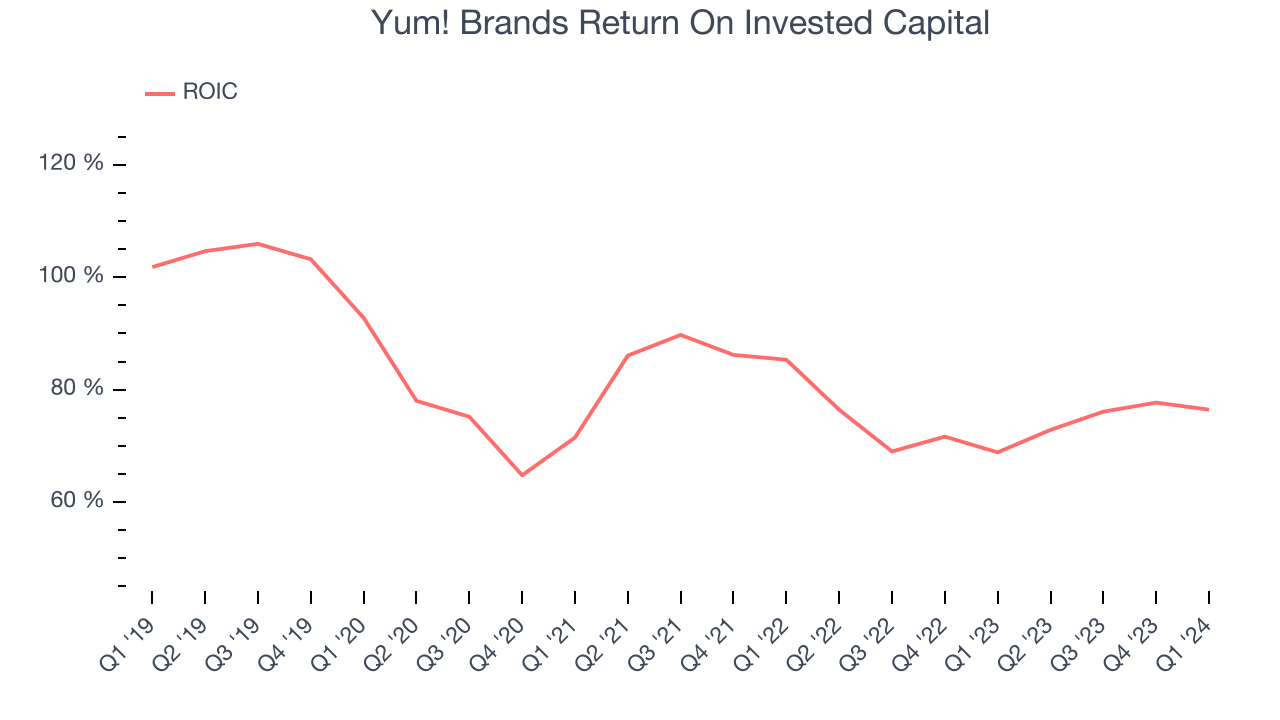
The trend in its ROIC, however, is often what surprises the market and drives the stock price. Unfortunately, Yum! Brands's ROIC averaged 9.5 percentage point decreases over the last few years. The company has historically shown the ability to generate good returns, but they have gone the wrong way recently, making us a bit conscious.
Key Takeaways from Yum! Brands's Q1 Results
Yum! Brands's revenue unfortunately missed analysts' expectations on lower-than-expected same store sales. Management cited a "difficult operating environment". Additionally, EPS missed Wall Street's estimates as well. Overall, this was a mediocre quarter for Yum! Brands. The company is down 5.8% on the results and currently trades at $133 per share.
Is Now The Time?
When considering an investment in Yum! Brands, investors should take into account its valuation and business qualities as well as what's happened in the latest quarter.
We think Yum! Brands is a good business. Although its revenue growth has been a little slower over the last five years, its growth over the next 12 months is expected to be higher. And while its projected EPS for the next year is lacking, its new restaurant openings have increased its brand equity. On top of that, its impressive operating margins show it has a highly efficient business model.
Yum! Brands's price-to-earnings ratio based on the next 12 months is 23.7x. There are definitely a lot of things to like about Yum! Brands, and looking at the consumer landscape right now, it seems the company trades at a pretty interesting price.
Wall Street analysts covering the company had a one-year price target of $144.50 per share right before these results (compared to the current share price of $133), implying they saw upside in buying Yum! Brands in the short term.
To get the best start with StockStory, check out our most recent stock picks, and then sign up to our earnings alerts by adding companies to your watchlist here. We typically have the quarterly earnings results analyzed within seconds of the data being released, and especially for companies reporting pre-market, this often gives investors the chance to react to the results before the market has fully absorbed the information.
